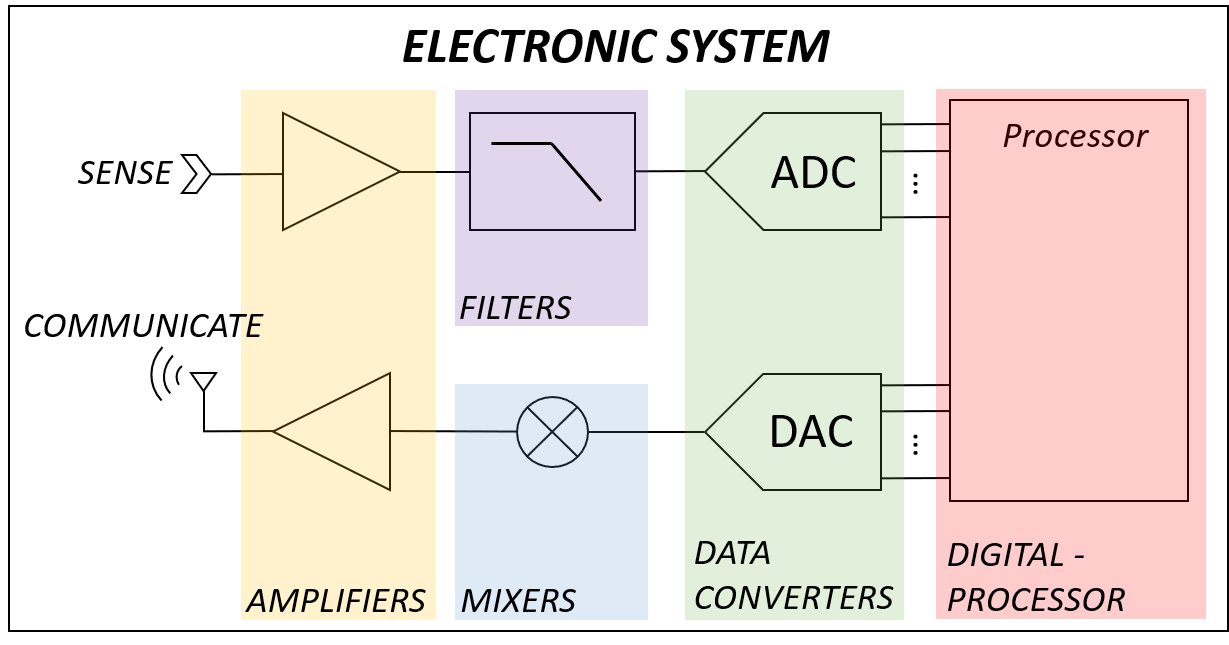ELEC-C9600 - Electronic circuits, Lecture, 26.2.2024-28.5.2024
Kurssiasetusten perusteella kurssi on päättynyt 28.05.2024 Etsi kursseja: ELEC-C9600
Osion kuvaus
-
Wishing to get fundamental knowledge to start understanding (and hopefully soon start designing) modern electronic equipment, including sensor interfaces, data converters, and computers? In this case, Electronic Circuits is an essential course for you! In this course, we will detail basic design mechanisms for (a) analog circuits, such as amplifiers and filters, (b) digital circuits, from gates to small computers, and (c) data converters interfacing both analog and digital worlds.

DISCLAIMER This course is considered to be the continuation course of "Basics in Electronics" from last autumn semester (ELEC-C9610). Hence lectures and exercises are the continuations of the ones from "Basics in Electronics". Students starting this course are expected to have a background covered in ELEC-C9610 or equivalent as a prerequisite. Therefore, the course is primarily intended for students in the "Digital Systems and Design (DSD)" bachelor program, but other students are also welcome to attend, given the prerequisite. However, students of the bachelor program in Electrical Engineering who have Electronics and Electrical Engineering as a major (EST) are not allowed to include the course in their degree as this course is considered redundant with other courses in their major.
-------------------------------------------------------------------------------------------------------------------------------
Summary of our rules in this course
- The course is organized around three main activities (see details by clicking on each activity): 1) Lecture, pre-tasks and discussion session; 2) Exercise assignment and 3) Simulation assignment.
- There is no final exam, but the evaluation is made by earning points for every activity. Grades are calculated regarding the number of points accumulated during the course (see Grading and study efforts).
- The total course duration is 14 weeks, but some have reduced or no activities due to spring holidays. See Course plan. Deadlines will be reminded to you by Email weekly.
- Every typical week of this course has (see Course plan) :
- One pre-task needs to be completed before each lecture. The pre-task must be submitted the day before the lecture (typically Monday evening).
- One lecture or one discussion session (Tuesdays from 14:15 to 16:00 FOR ALL). Lectures are assumed to continue the "Basics in Electronics" course. Before every lecture, the Coursebook will contain the lecture materials (you can print them in pdf directly if needed).
- One return session for the exercise assignment (Mondays 10:00 to 12:00 FOR ALL). You can book a 12-minute time slot with a teacher to return and/or discuss your exercises answers. Participating in the exercise return session is optional, but teachers strongly encourage that students take advantage of the opportunity to correct possible mistakes in exercise answers and, if needed, get further lectures by a teacher. Teachers are there to help you! Your finalized answers are to be submitted in a return box closing on Tuesday at noon.
- Additionally, three extra simulation assignments are planned along the course to give you practical experience with the simulator software KiCad.
- Teachers in this year are Prof. Martin Andraud, Dr. Aleksi Tamminen, Dr. Juha Mallat, Prof. Katsuyuki Haneda, Mr. Ali Kourani and Ms. Lingyun Yao.
--------------------------------------------------------------------------------------------------------------------------------Intended learning outcomes (ILO)- ILO1 – After the "AC analysis and power" part of the course (Weeks 1 and 2), students will be able to interpret quantities such as amplitude, phase, frequency, magnitude, or power to perform Alternating Current (AC) analysis on simple circuits. This will be assessed with exercise assignments.
- ILO2 – After the "Frequency analysis and filters" part (Week 3-5), students will be able to interpret quantities such as poles, zeros, and resonance. They will apply this to perform frequency analysis through transfer functions and be able to build basic filters (orders 1 and 2 mostly). This will be assessed through exercise assignments and one simulation assignment.
- ILO3 – In the "Analog versus digital circuits and introduction of MOS transistor" part (Weeks 7-9), students will clarify the main differences between analog and digital circuits. They will also interpret how the MOS transistor works. This will be assessed through exercise assignments.
- ILO4 – After the "digital circuits and basic processor architecture" part (Weeks 10 and 11), students will be able to analyze basic binary and digital circuits (logic gates, latches, multiplexers, adders, etc.). They will also be able to describe a simple processor's main blocks. This will be assessed through exercise assignments and one simulation assignment.
- ILO5
– After the "systems and data converter" part (Weeks 12 and 13), students will be introduced to basic concepts and circuits
performing data conversion. They will have an intuitive understanding of
concepts such as quantization and sampling and be able to describe basic data
converter topologies. This will be assessed through exercise assignments and one
simulation assignment.
- ILO6 – In addition, after the course, students can interpret the main blocks of modern electronic systems and identify their general role. This will be assessed through the last reflective assignment on systems in week 14.
- ILO7 – Students will also practice their communication skills in exercise return sessions and discussion sessions and be able to communicate with an international group of teachers and students. This will not be formally assessed but practiced throughout the course.
